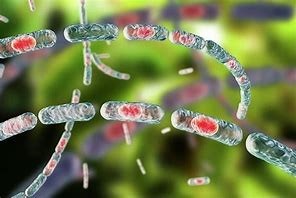Last updated: April 25, 2023
Article
Anthrax

THE BASICS
Humans: Anthrax is a disease caused by the bacteria Bacillus anthracis. Humans can become infected when they inhale bacterial spores, eat food or drink water that is contaminated with spores, or get spores in a cut or scrape on the skin. Anthrax is not usually transmitted from one person to another. People who handle or work with animals that have died from anthrax could be exposed if safe practices are not followed, including the appropriate use of Personal Protective Equipment (PPE). Occupational groups who may be at risk for anthrax include farmers, veterinarians, livestock handlers, diagnostic laboratory workers, and those who work with animal products.
The symptoms of anthrax depend on the route of exposure to the bacteria (contact, injection, inhalation, ingestion). Symptoms usually occur one to seven days after exposure but can occur up to two months after exposure for inhalation anthrax. Cutaneous anthrax, affecting the skin, is the most common type of anthrax infection seen in the United States. If people have skin contact with the bacteria, they can experience blisters or bumps, itchiness, swelling, or a painless (sometimes black) skin sore or scab. The form of anthrax that affects the skin most often occurs on the face, neck, arms, or hands. If the bacteria are injected (e.g., through contaminated IV drug use), symptoms may be similar to cutaneous anthrax but can also infect the muscle or enter the bloodstream. If the bacteria are inhaled, people can experience fever and chills, chest discomfort, shortness of breath, confusion, dizziness, cough, and other symptoms. If the bacteria are ingested, people can experience fever, chills, swelling of the neck or glands, sore throat, nausea, vomiting (possibly bloody), diarrhea, and other symptoms.
Anthrax has a high mortality rate. There is a pre-exposure anthrax vaccine that is available for certain individuals under specific circumstances, and there are several options for both post-exposure prophylaxis and treatment including vaccine, antibiotics, and anti-toxin.
Animals: Animals most frequently become infected by ingesting spores found in the environment or by ingesting other infected animals; infection may also occur via biting flies. Herbivores, including cattle, sheep, goats, horses, and deer are the animals most often infected with anthrax. As they eat grass and plants they can ingest or inhale the bacteria. Dogs, cats, and other carnivores are very rarely infected with anthrax, but infection could occur after consuming other infected animal meat. Infected animals may appear unstable and stagger, have difficulty breathing, exhibit trembling, and ultimately collapse and die within a few hours. Pre-exposure anthrax vaccine is recommended for livestock in areas where the bacteria is a concern, such as where previous livestock deaths from anthrax have been reported. Some infected animals may respond to antibiotic therapy, but often by the time disease is recognized it is too late for treatment.
Environment: The bacteria are spore-forming which allows them to survive in soil, plants, and water for many years. The spores are easily aerosolized under the right conditions and resistant to environmental degradation. The bacteria contaminate surface soil and grass after certain weather conditions, including periods of wet, cool weather, followed by several weeks of hot, dry conditions. Climate change is contributing to anthrax occurring in areas where it was previously unlikely. Warmer temperatures and ground thawing promote spore exposure in Arctic environments. Environmental surfaces and personal items potentially containing the spores may be treated with 0.5% hypochlorite after consulting with the proper contacts (see response section below).
PREVENTION
- Only consume treated or boiled water and be sure to cook meat thoroughly.
- Wear gloves if you hunt, trap, or skin animals.
- Be aware of anthrax-endemic areas.
- For employees, if you must handle an animal or animal carcasses, follow guidance in the USGS guide to Safe Work Practices for Working with Wildlife to prevent exposure.
- Utilize PPE to take when doing construction/excavation or other activities that require soil disturbance with risk of spore exposure. See the National Institute for Occupational Safety and Health (NIOSH) resource titled Anthrax: Recommendations for Protecting Workers
- If you become ill following a potential exposure, contact your healthcare provider and let them know of your concern. Also, please report any confirmed illnesses to the NPS Office of Public Health publichealthprogram@nps.gov as directed in the “Disease Reporting” guidance below.
- Report concerns about sick or dead wildlife to the park resource manager and the Wildlife Health Branch at npsdiagnostics@nps.gov.
Last updated: 12/27/2022

- CDC Anthrax Website
- CDC Anthrax: Recommendations for Protecting Workers
- USGS Safe Work Practices for Working With Wildlife
NPS-SPECIFIC PUBLICATIONS
- Florida Retiree Gets—and Survives—Anthrax. Centers for Disease Control and Prevention. Published Nov 20, 2020. Accessed 2022. https://www.cdc.gov/anthrax/resources/features/minnesota-case.html.
- Adjemian J, Weber IB, McQuiston J, et al. Zoonotic infections among employees from Great Smoky Mountains and Rocky Mountain National Parks, 2008-2009. Vector Borne Zoonotic Dis. 2012;12(11):922-931. doi:10.1089/vbz.2011.0917
- Griffith J, Blaney D, Shadomy S, et al. Investigation of Inhalation Anthrax Case, United States. Emerg Infect Dis. 2014;20(2):280-283. doi:10.3201/eid2002.130021Griffith J, Blaney D, Shadomy S, et al. Investigation of inhalation anthrax case, United States. Emerg Infect Dis. 2014;20(2):280-283. doi:10.3201/eid2002.130021.
